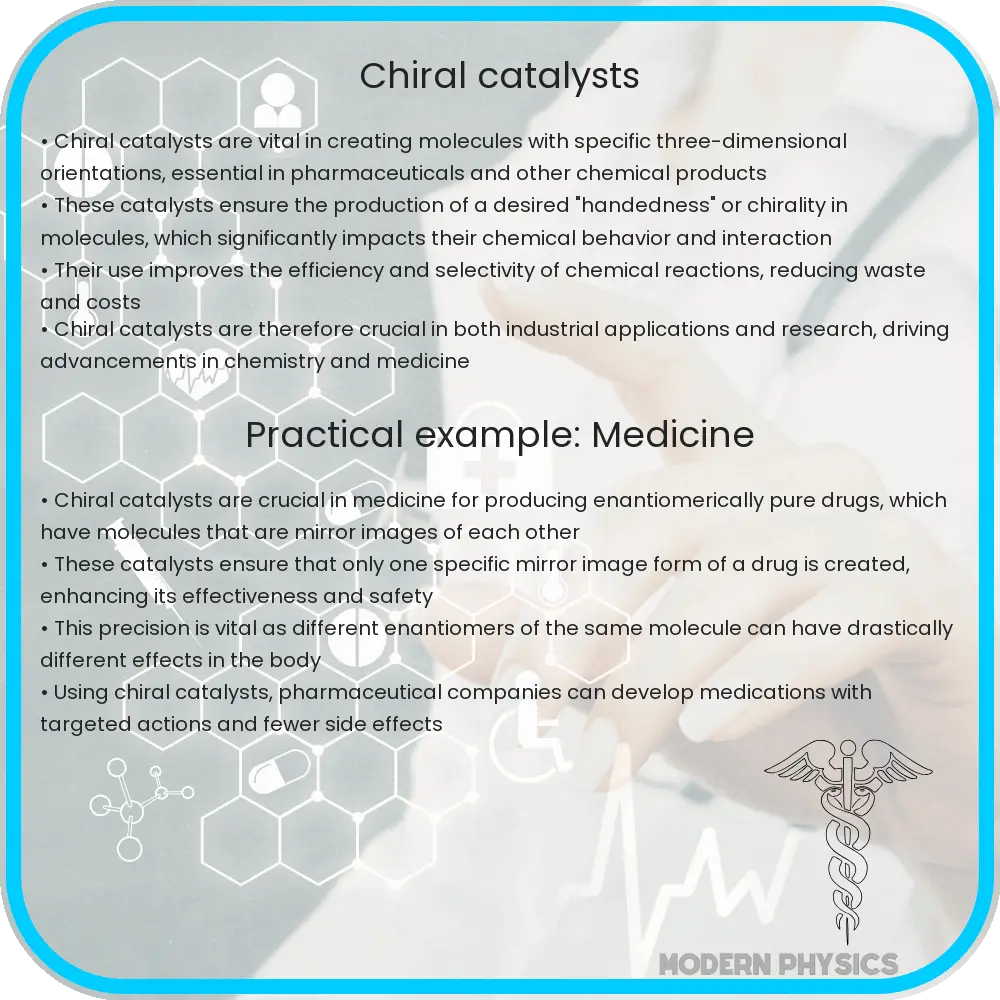Chiral catalysts are substances that accelerate chemical reactions and control outcomes by favoring the formation of specific molecule mirror images, critical in pharmaceutical and material sciences.

Understanding Chiral Catalysts: Precision, Efficiency, and Reactivity
Chiral catalysts stand at the forefront of modern chemistry and materials science, enabling precise reactions that are crucial for the development of pharmaceuticals, agrochemicals, and new materials. Chirality – a property where a molecule or a spatial arrangement is not superimposable on its mirror image – plays a critical role in the efficacy and safety of many compounds. This article explores how chiral catalysts harness this property to drive reactions with remarkable precision, efficiency, and selectivity.
The Significance of Chirality in Chemistry
In many chemical compounds, especially those involved in biological processes, chirality is a key factor that affects their behavior and interaction with other molecules. For instance, the two chiral forms (enantiomers) of a molecule may have vastly different biological effects; one might be beneficial while the other could be harmful or inert. Thus, the ability to control chirality during synthesis is crucial for producing effective and safe pharmaceutical products.
What Are Chiral Catalysts?
Chiral catalysts are substances used to induce and accelerate chemical reactions while controlling the chiral outcome of the reaction. These catalysts are themselves chiral, meaning they are composed of molecules that exhibit handedness. Such specificity allows chiral catalysts to preferentially catalyze the formation of one enantiomer over another, thus promoting asymmetry in a reaction that would otherwise produce a racemic (50/50) mixture of enantiomers.
How Chiral Catalysts Work
The effectiveness of chiral catalysts lies in their ability to form temporary, chiral-active sites during the reaction process. These sites interact differently with the enantiomers of a particular substrate due to their three-dimensional spatial arrangement. Consequently, one enantiomer may be formed preferentially, enhancing the product’s purity and potentially reducing the need for further costly and wasteful purification processes.
- Temporal control: By manipulating the reaction environment, chiral catalysts can direct the course and duration of a chemical reaction, ensuring that the desired enantiomer is produced more efficiently.
- Spatial control: The three-dimensional structure of chiral catalysts allows for precise spatial interactions with substrate molecules, which is essential for achieving high enantioselectivity.
- Reactivity: Chiral catalysts can increase the reactivity of substrate molecules, making it easier to achieve reactions under milder conditions and lower energy requirements.
Applications of Chiral Catalysts
The applications of chiral catalysts are extensive and impactful. In pharmaceuticals, the use of these catalysts can lead to the synthesis of bioactive molecules with improved efficacy and reduced side effects. Additionally, chiral catalysts are employed in the creation of specific polymers, agrochemicals, and even fragrances that require a high degree of purity and specificity.
One notable example is the synthesis of the anti-inflammatory drug ibuprofen. Traditionally, ibuprofen was synthesized through a process that produced a racemic mixture of its enantiomers. However, only one of the enantiomers is biologically active towards reducing inflammation. Using chiral catalysts, chemists can now selectively produce the active form of ibuprofen, enhancing the drug’s overall effectiveness and reducing the production of unwanted byproducts.
Challenges and Future Directions in Chiral Catalyst Development
Despite their broad utility, the development and application of chiral catalysts face several challenges. One key issue is the need for continual innovation to create catalysts that are more efficient, selective, and environmentally friendly. Additionally, the synthesis of chiral catalysts can be complex and costly, often requiring rare or expensive materials.
Future advancements may focus on the discovery of novel catalysts that can operate effectively under a wider range of conditions and substrates. Researchers are also exploring the possibility of using biocatalysts—enzymes that perform similar functions in nature—which could offer more sustainable and cost-effective solutions. Furthermore, advancements in computational chemistry and machine learning could accelerate the design and testing of new chiral catalysts, making the development process faster and less resource-intensive.
Sustainability and Environmental Impact
The design of green chiral catalysts is another important frontier. These catalysts aim to minimize waste and reduce the environmental footprint of chemical processes by using less hazardous materials and solvents. Moreover, the ability to derive more product from less starting material and energy also aligns with principles of green chemistry, contributing to more sustainable manufacturing practices.
For instance, some modern chiral catalysts are designed to be recyclable, retaining their effectiveness over multiple cycles. This not only reduces waste but also cuts down on the chemical industry’s reliance on non-renewable resources.
Conclusion
Chiral catalysts represent a vital tool in the arsenal of modern chemistry and materials science, offering unparalleled precision in the synthesis of complex molecules. By enabling the selective production of particular enantiomers, these catalysts have revolutionized the pharmaceutical industry, improved agricultural chemicals, and facilitated the creation of innovative materials. Despite facing challenges such as high cost and complex synthesis processes, ongoing research and technological advancements hold the promise of overcoming these hurdles. Future developments focused on sustainability, efficiency, and the integration of biocatalysis and computational approaches are likely to expand the applications and effectiveness of chiral catalysts. As we continue to unveil new ways to manipulate molecular interactions, the potential of chiral catalysts to impact a variety of industries becomes ever more apparent, reinforcing their critical role in advancing science and technology.
